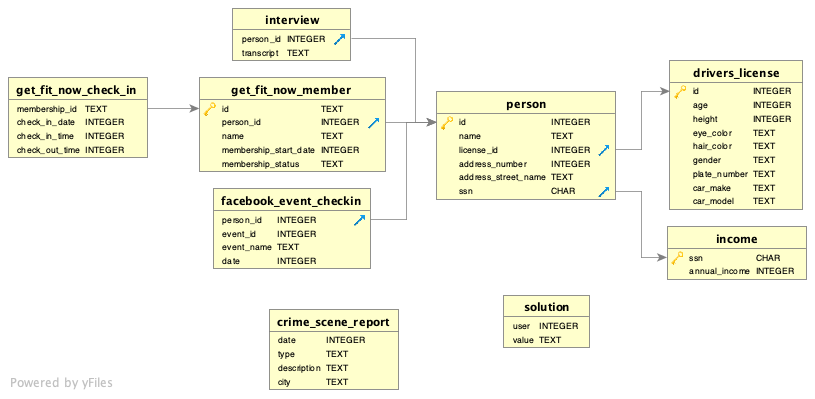library(tidyverse)
url("https://raw.githubusercontent.com/manncz/stat-331-s25/main/labs/lab5/data/bCH_murder_data.Rdata") |>
load()Lab 5: Murder in SQL City
join + stringr + ludridate
For this lab, you will be joining and filtering related datasets to solve a murder mystery!
Instructions
Northwestern University’s Knight Lab wanted to help sharpen users’ database skills, so they created a murder mystery. Can you solve this crime in SQL City??
The relational data you will be working with contains tables with different pieces of information pertinent to the crime - people, social media check-ins, driver’s licenses, crime scene reports, police interviews, and more!

Access the Data
This code chunk will read in all of the tables of data for you. Don’t modify or remove this!
If the code above does not work for you for some reason, you can download the special data file here and use the load() function to read it in.
Clean and Combine the Data
Let’s set ourselves up to solve this crime lickity-split!
0.1 Use a stringr function(s) and a regular expression(s) to create address_number and address_street_name columns in the person dataset. Convert the address_number variable to numeric.
# code for Q0.10.2 Design and implement a check that you created the address_number and address_street_name columns correctly.
For example, if you re-combine the address_number and address_street_name columns, you should get the same value as original address column exactly.
# code for Q0.20.3 Create two new datasets:
get_fit_now_full- every row represents one visit to the “Get Fit Now” gym.
- all member information is included (e.g. check in times, names, and membership information)
- should have 2,703 rows and 8 columns
suspects_all- each row represents one person
- includes their address, driver’s licence information, income, and interview with the police, if they have one
- drop the
addresscolumn - should have 10,011 rows and 16 columns
Don’t worry about missing values! We are just gathering all of the information that we have about everyone.
# code to create get_fit_now_full# code to create suspects_allSolve the Crime
Crime Scene Report
Detective Wickham reaches out to you…
A crime has taken place and I need your help! There was a murder in SQL City sometime on Jan.15, 2018. Could you retrieve the crime scene report from the police department’s database and follow the clues to find the person responsible for the murder?!
Solve the murder mystery, showing all of your work in this document. Your document and code must be well organized, easy to follow, and reproducible.
- Use headers and written descriptions to indicate what you are doing.
- You must use
dplyrverbs andjoinfunctions rather than just looking through the tables manually. - You should never filter on a specific person id – rather use
joinfunctions - You should have a final output that just includes the murder’s name as well as their interview transcript (which is missing!).
- Use the data frames you just created when helpful!
- Use good code formatting practices.
- Comment your code.
- Cite any external sources you use to solve the mystery.
Use kable() to nicely output clues!
Follow the evidence to the person responsible for the murder, building a report as you go.
# code for looking at the relevant crime scene report.
# you will want to use multiple chunks!Make sure you check for interviews with any suspects and anyone mentioned!
The murderer will have no interview - don’t stop until you find them!
put the name of the person responsible for the murder here.